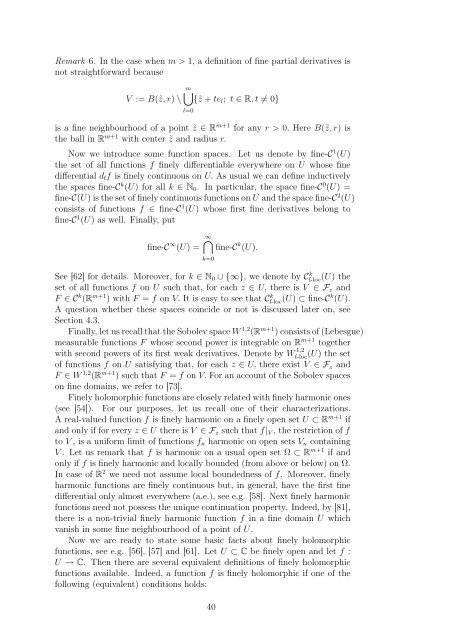Hypercomplex Analysis Selected Topics
Hypercomplex Analysis Selected Topics
Hypercomplex Analysis Selected Topics
You also want an ePaper? Increase the reach of your titles
YUMPU automatically turns print PDFs into web optimized ePapers that Google loves.
Remark 6. In the case when m > 1, a definition of fine partial derivatives is<br />
not straightforward because<br />
V := B(˜z, r) \<br />
m<br />
{˜z + tel; t ∈ R, t = 0}<br />
l=0<br />
is a fine neighbourhood of a point ˜z ∈ R m+1 for any r > 0. Here B(˜z, r) is<br />
the ball in R m+1 with center ˜z and radius r.<br />
Now we introduce some function spaces. Let us denote by fine-C 1 (U)<br />
the set of all functions f finely differentiable everywhere on U whose fine<br />
differential dff is finely continuous on U. As usual we can define inductively<br />
the spaces fine-C k (U) for all k ∈ N0. In particular, the space fine-C 0 (U) =<br />
fine-C(U) is the set of finely continuous functions on U and the space fine-C 2 (U)<br />
consists of functions f ∈ fine-C 1 (U) whose first fine derivatives belong to<br />
fine-C 1 (U) as well. Finally, put<br />
fine-C ∞ (U) =<br />
∞<br />
fine-C k (U).<br />
k=0<br />
See [62] for details. Moreover, for k ∈ N0 ∪ {∞}, we denote by Ck f-loc (U) the<br />
set of all functions f on U such that, for each z ∈ U, there is V ∈ Fz and<br />
F ∈ Ck (Rm+1 ) with F = f on V. It is easy to see that Ck f-loc (U) ⊂ fine-Ck (U).<br />
A question whether these spaces coincide or not is discussed later on, see<br />
Section 4.3.<br />
Finally, let us recall that the Sobolev space W 1,2 (Rm+1 ) consists of (Lebesgue)<br />
measurable functions F whose second power is integrable on Rm+1 together<br />
(U) the set<br />
with second powers of its first weak derivatives. Denote by W 1,2<br />
f-loc<br />
of functions f on U satisfying that, for each z ∈ U, there exist V ∈ Fz and<br />
F ∈ W 1,2 (Rm+1 ) such that F = f on V. For an account of the Sobolev spaces<br />
on fine domains, we refer to [73].<br />
Finely holomorphic functions are closely related with finely harmonic ones<br />
(see [54]). For our purposes, let us recall one of their characterizations.<br />
A real-valued function f is finely harmonic on a finely open set U ⊂ Rm+1 if<br />
and only if for every z ∈ U there is V ∈ Fz such that f|V , the restriction of f<br />
to V , is a uniform limit of functions fn harmonic on open sets Vn containing<br />
V . Let us remark that f is harmonic on a usual open set Ω ⊂ Rm+1 if and<br />
only if f is finely harmonic and locally bounded (from above or below) on Ω.<br />
In case of R2 we need not assume local boundedness of f. Moreover, finely<br />
harmonic functions are finely continuous but, in general, have the first fine<br />
differential only almost everywhere (a.e.), see e.g. [58]. Next finely harmonic<br />
functions need not possess the unique continuation property. Indeed, by [81],<br />
there is a non-trivial finely harmonic function f in a fine domain U which<br />
vanish in some fine neighbourhood of a point of U.<br />
Now we are ready to state some basic facts about finely holomorphic<br />
functions, see e.g. [56], [57] and [61]. Let U ⊂ C be finely open and let f :<br />
U → C. Then there are several equivalent definitions of finely holomorphic<br />
functions available. Indeed, a function f is finely holomorphic if one of the<br />
following (equivalent) conditions holds:<br />
40

















